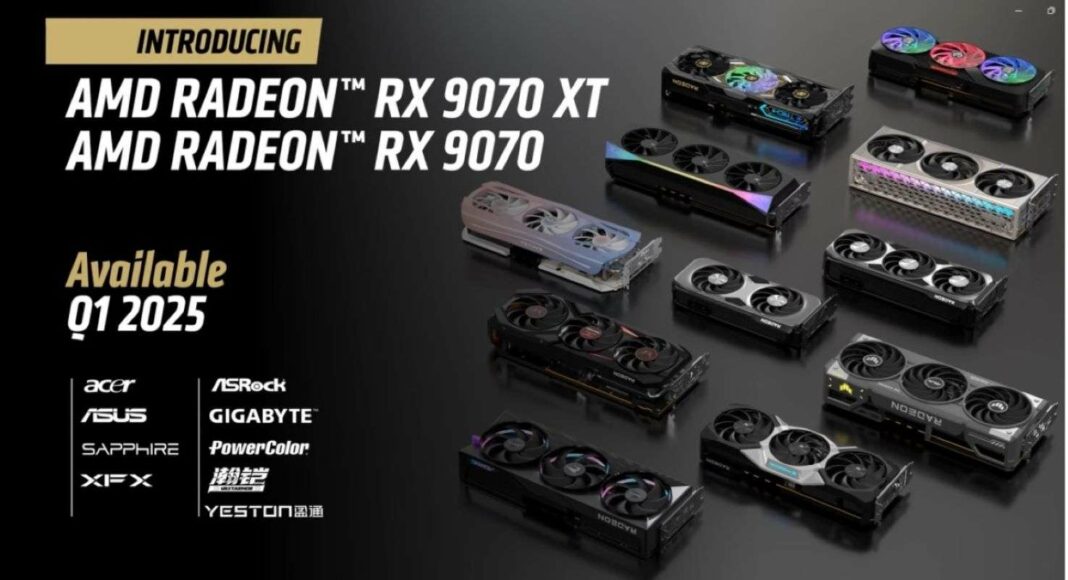AMD has introduced the Radeon RX 9070 and 9070 XT graphics cards, leveraging the advanced RDNA 4 architecture with enhanced AI capabilities through FidelityFX Super Resolution 4. While details remain limited, these GPUs aim to compete with Nvidia’s DLSS by incorporating dedicated AI hardware for better performance. AMD’s new model numbering aligns with Ryzen branding, positioning the RX 9070 series against Nvidia’s RTX 4070. More information is anticipated ahead of their launch in early 2025.
AMD Unveils the Radeon RX 9070 and 9070 XT
In a prelude to the CES 2025 keynote on Monday, AMD has showcased its latest graphics cards, the Radeon RX 9070 and 9070 XT. Built on the cutting-edge RDNA 4 architecture, these GPUs feature an innovative AI-focused version of FidelityFX Super Resolution (FSR).
For gamers eager for comprehensive insights, the preview left much to be desired; details were scarce, with the Radeon 9070 notably absent from AMD’s main presentation. Instead of a full reveal, AMD offered merely a glimpse, signaling that the integration of real AI hardware into their GPUs is finally underway. Historically, AMD has faced challenges against Nvidia’s acclaimed DLSS, primarily relying on graphics cores without dedicated AI components, a trend that the 9070 (XT) aims to reverse.
Revolutionary Architecture and Performance Enhancements
AMD has developed RDNA 4 on TSMC’s advanced 4nm process, promising enhanced AI performance through a significant rework of its AI computing architecture. The upcoming Radeon GPUs will not only feature enhanced ray tracing architecture but will also see substantial upgrades in the encoding and decoding capabilities through AMD’s second-generation Radiance Display Engine.
While the initial announcements are promising, the specifics of this ambitious architectural evolution remain elusive as AMD has yet to provide further insights. One notable addition is the new software feature, FidelityFX Super Resolution 4, which focuses on machine learning-based upscaling, akin to Nvidia’s DLSS. AMD highlighted this innovation with a screenshot from Call of Duty: Black Ops 6, hinting at “dramatic” performance and quality improvements over earlier FSR versions.
This advancement is particularly relevant given that AMD’s previous GPU-based FSR technology has lagged in comparison to DLSS and Intel’s XeSS, which utilize dedicated AI hardware for seamless, upscaled gaming experiences.
In a further nod to AI integration, AMD’s Adrenalin software will introduce a generative AI tab, enabling users to create images from text or summarize local documents, showcasing the company’s commitment to leveraging AI technology.
AMD rounded off its teaser with images of the Radeon RX 9070 graphics cards from various board partners, though MSI was notably absent. Additionally, AMD shared a slide explaining its new model number strategy: transitioning to the 9000 series to align with the Ryzen 9000 series branding, while also reclassifying certain GPUs from the 100 series to the 10 series to match Nvidia’s naming conventions. The Radeon RX 9070 (XT) is positioned as a direct competitor to Nvidia’s RTX 4070 (Ti).
It appears AMD is strategically withholding detailed information about RDNA 4 until after Nvidia’s keynote, where they will unveil the anticipated GeForce RTX 50 series GPUs. This approach may allow AMD to assess their competitor’s pricing and performance before finalizing their own market positioning.
Ultimately, the emergence of dedicated AI hardware within AMD’s offerings marks an exciting evolution in graphics technology, with the potential to revolutionize gaming experiences through advanced AI upscaling. More details about the Radeon RX 9070 and RDNA 4 are expected to emerge ahead of their launch in the first quarter of 2025.
